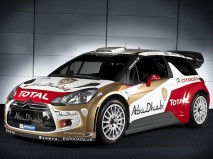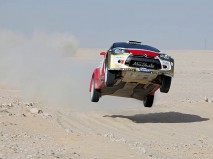2013 Citroen DS 3 WRC
Used since the current FIA regulations came into effect in 2011, the DS3 WRC is packed full of Créative Technologie. It was the World Champion car in 2011 and 2012, and has proved a wor- thy successor to the Xsara and C4 WRC.
Fine-tuned during extensive wind tunnel testing, DS3 WRC’s bodywork accentuates the curves of the original model. The wings and the bumpers have been redesigned in order to attain the maximum autho- rised width of 1,820mm and to accommodate the 18-inch wheels (tarmac version). The front bumper now includes an aerodynamic splitter, whilst a stylish rear spoiler has been attached to the tailgate. The doors have also been altered, with the installation of polycarbonate fixed frame windows and the injection of foam designed to absorb energy in the event of a side impact.
Built using the production body shell, the DS3 WRC chassis includes a roll cage made of over 40 metres of steel tubing. The lower part has undergone several significant structural modifications: upper attach- ment points added for the rear McPherson-strut suspension, optimisation of the lower suspension at- tachment points, integration of the transmission tunnel and the rear differential, lateral reinforcements added level with the body sills.
Slightly smaller than before in order to comply with the regulations, the 355mm (tarmac) and 300mm (gravel) brake disks at the front, and the 300mm brake disks at the rear, come with four-piston callipers. A water-cooling system improves the efficiency of the brakes on tarmac.
Housed in a machined aluminium block, the exquisitely crafted four-cylinder 1600cc engine complies with the requirements of the regulations, which stipulate in particular a minimum weight and a position for the centre of gravity. It is on the car’s 16-valve cylinder head that the main change has taken place. Mandatory in WRC, direct injection posed a real challenge for the engine specialists at Citroën Racing. Fuel is only mixed with air once it has been injected into the combustion chamber.
Each car cannot use more than three engines during the season.
The six-speed sequential gearbox and the front differential are integrated in an aluminium housing. These are connected to the rear differential via a longitudinal drive shaft. The central differential is prohibited, but a system may be used to disconnect the rear wheels when using the hydraulic hand brake.













